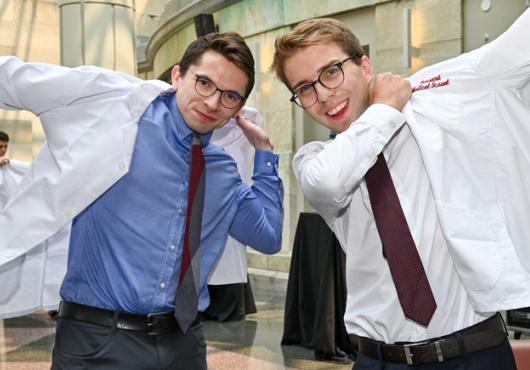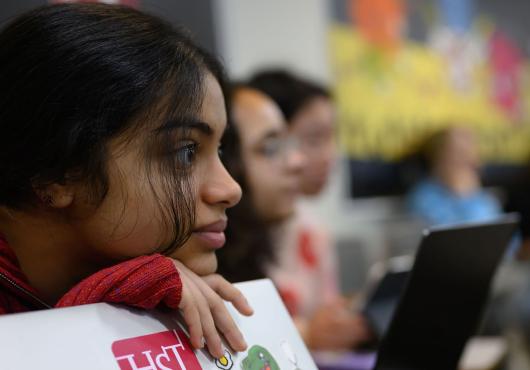
Sanjat Kanjilal, an infectious disease physician at Brigham and Women’s Hospital and now a Harvard Medical School faculty member, graduated from the Harvard-MIT Health Sciences and Technology program in 2010.
While still a student in 2005, Kanjilal took the HST 040 microbial pathogenesis course, which has been taught at the School for 30 years. Only a little more than a decade after graduating, he’s now its first-year course director and, together with a colleague, has revamped the HST040 curriculum.
They now have even more work ahead: an overhaul of the entire HST curriculum.
“Basically, we started from scratch. We took the skeleton of the structure of the course, which is broken up into four blocks, and essentially did a reappraisal of what was going on in each of those four blocks,” Kanjilal, said. “We invited a lot of new people to teach—51 different guest lecturers. I personally wrote 11 lectures from scratch.”
After its inaugural semester in fall 2021, students gave the reworked pathogenesis course high ratings, Kanjilal said, but he’s committed to making it even better going forward.
“I think there can be a need for improving the way we convey our knowledge. Improved data visualizations, study guides, integration with existing, more popular study resources, but also continuing to adhere to the HST philosophy, which is understanding pathophysiology from the mechanism standpoint,” he said.
In the new course, Kanjilal said, they broadened the types of research covered and expanded beyond foundational basic science to include topics such as artificial intelligence and translational research topics. The instructors also covered COVID-19 health care disparities, economics, and large-scale epidemiologic studies, and invited a diverse group of scholars to be guest lecturers.
Instead of using a set textbook, a compendium of articles was created to help illustrate major concepts. Kanjilal also changed evaluation methods, moving away from two primary exams to four small quizzes and incorporating regular random recall questions into each class from previous lectures. Next year, he wants to introduce a social media component.
“I think the belief is that a physician-scientist is not someone who just pipettes at the bench. It’s someone who does that, but who also can be working out on the frontlines, or in front of a computer, or by advocating in front of legislators,” he said.
HST curriculum reform task force
After reworking the course, Kanjilal was asked to be part of a newly launched task force that HMS Dean George Q. Daley has charged with innovating the entire HST curriculum, an effort similar in scope to the restructuring of its sister MD Pathways curriculum, relaunched in 2015.
Wolfram Goessling, HMS director of the Harvard-MIT Division of Health Sciences and Technology and the Robert H. Ebert Professor of Medicine, said that early this year an initial task force of 20 HST and MIT faculty, along with HMS students, began defining the scope of work to be done over the next 18 to 24 months. The goal: completely reinvent the program for the next half-century of HST learners.
“To train students who are committed to becoming physician-scientists, all aspects of the curriculum need to be intentionally focused on that goal. We will inspire patient-centered innovation and integration of clinic and scientific inquiry. This is a daunting task, and we are ready for it,” Goessling said.
“If HST is the program at HMS that trains physician-scientists, a science-based curriculum needs to be integrated with the development of clinical skills and reasoning and an opportunity to actively participate in innovation at the forefront of medicine,” Goessling said. “These are the aspects we are now discussing in the task force.”
In January, Daley, himself an alumnus of the HST program, gave Goessling the directive to start the reform process.
“Our HST program has had a notable record of success focusing on translational medical science and engineering, but medicine and technology have evolved tremendously since the program was first created in 1970. It’s now time to adapt and determine how to best train the physician-scientists and innovators of the future, and how to optimally leverage the resources of both HMS and MIT for the next 50 years,” Daley said.
Goessling said some of the questions being considered by the curriculum reform task force revolve around how to best integrate the program’s stellar basic science curriculum with other important components that will address racism in medicine, social inequities, and other nonbiologic and structural determinants of health. The task force will also improve alignment between basic science teaching by both Harvard and MIT faculty, clinical experiences, and active research for the entire duration of study.
HST students are also on the task force. Adam Berger, a fifth-year MD-PhD student whose biomedical engineering research focuses on gene therapies to improve tissue regeneration, is one of them.
Berger said many students are interested in an HST curriculum that might be a little less prescriptive, allowing students more freedom to pursue a wider variety of research interests. And while the students value HST’s emphasis on understanding the mechanisms driving human health and disease, Berger said many have expressed an interest in getting into the clinic even earlier.
“We had a little bit of delayed gratification,” said Berger, who, in his first year, did not meet with patients right away, although HST students now do. He added that he would like to see a new curriculum reinforce “the whole arc of how patients inform medical research and how medical research informs patient care. I really see that as the innovation driving HST.”
Innovation, Berger believes, should be the keystone around which a revamped curriculum is built, because it will teach students how to create new treatments and improve patient care.
One way to foster new ideas, he said, would be, “Getting students very integrated into the clinic early on to understand how their kind of innovation can make an impact, while not getting rid of the fundamental paradigm of HST, where you really do learn from the ground up,” he said.
Like Kanjilal, Berger also thinks the program can benefit from incorporating newer pedagogical approaches, such as the use of more multimedia.
“For example, if you’re learning about colon cancer and the mechanisms behind that, seeing an endoscopy helps put the whole picture together, versus what is presented in a textbook, which can’t really do that in the same way,” he said. “I think a multimedia approach is certainly helpful in bringing everything together to provide students with the opportunity to learn how they learn best.”
A fresh start
HST associate directors Daniel Solomon and Junne Kamihara said the task force’s charge is an exciting one, because it does not ask for incremental change to the curriculum, but instead calls for a fresh start, even a reexamination of the program’s core principles and goals, while retaining the rigorous foundational program in the basic sciences.
“As we approached the 50th anniversary of HST, we were charged with thinking about how we would create a curriculum if Irving London were here today, as he did when he initially founded the HST curriculum,” said Kamihara, a 2008 HST alumna and HMS instructor in pediatrics at Dana-Farber Cancer Institute.
She added, “HMS has really encouraged us to try to think in a ‘blue sky’ kind of fashion, to think about how we could reimagine and reinvigorate the curriculum for physician-innovators of the future.”
Solomon, HMS instructor in medicine at Brigham and Women’s, echoed Berger’s assertion that many students are eager to get into the clinic earlier.
“They really want to have more interaction with patients earlier on in their training in a way that can help contextualize some of the foundational basic science that they’re learning,” he said, adding, “I do think that those formative clinical experiences can shape the types of physicians we train and the types of questions they ask as researchers.”
What’s more, he said, today’s students are calling for an even larger context for the work they will be doing as physician-scientists.
“Students, I think, are awake to some of the forces outside of medicine that are impacting human health, that we didn’t have a strong recognition of 10, 20, 30 years ago. Things like structural racism, or climate change’s impact on health,” Solomon said.
Andrea Reid, associate dean for student and multicultural affairs and director of the Office of Recruitment and Multicultural Affairs at HMS, is also part of the HST curriculum reform task force.
She said the task force is working to determine how to advance the program’s movement toward a more diverse and inclusive student body, while at the same time ensuring that HST students receive the training they’ll require to respond to the health care needs of an increasingly diverse nation and world. That means looking closely at the curriculum.
“How do we talk about medical mistrust and why that’s relevant for the physician-innovator and the physician-scientist? How do we talk about the inequities in research, the inequities in health care outcomes, and the inequities in the lived experience in our diverse nation?” Reid said. “It’s deeply relevant and should not be an add-on to the curriculum, but should be central to the curriculum.”
Reid said today’s students have an expectation that faculty are thinking about these kinds of issues in a very real way and should integrate them seamlessly into their course materials.
“These individuals are going to run research programs. Many of them will run high-profile, highly productive research programs. And if we teach them now, as they’re just developing, about bias and social determinants of health, and how to lead a diverse group, and if we model it, then they will take that into their own laboratories in the future and create labs where underrepresented scientists will want to train, do their gap years, and their postdocs. It really does start with them,” Reid said.





